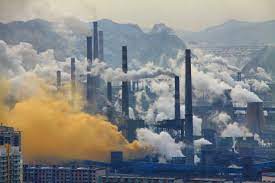
While the world's second-largest economy struggled to fully recover from the long-term consequences of COVID, the decline in the earnings of Chinese industrial enterprises grew in the first two months of 2023. This decline was exacerbated by lackluster demand and persistently high expenses.
According to figures released on Monday by the National Bureau of Statistics (NBS), the industrial profits for the entire of 2022 fell by 4.0% before the severe 22.9% contraction, indicating a gloomy start to the year for manufacturers as a whole.
According to a statement on the NBS website, statistician Sun Xiao explained the fall as a result of the demand being remained weak despite an increase in industrial output.
A fall in auto industry earnings, according to Zhou Maohua, an analyst at China Everbright Bank, was a significant drag on manufacturing profits. This was largely due to a reduction in overall demand, rising production costs, dwindling auto subsidies, and price wars.
"Currently, international commodity prices remain at high levels and overseas demand is still on a downtrend," Zhou wrote. "Industrial and manufacturing departments still need to offer policy support, alleviating fiscal, cost and financing pressures and stabilizing firm confidence."
A breakdown of the 887.21 billion yuan ($128,92 billion) profits showed that private-sector companies' profits fell 19.9% while those of foreign companies fell 35.7%.
28 of the 41 major industrial sectors saw a decline in profits during the time period, with the manufacturing of computers, telephones, and other electronic equipment reporting the sharpest decline at 77.1%.
The economic numbers released on Monday come after a rush of signs that indicate an uneven recovery from the brutal three-year fight against the COVID outbreak.
According to figures released earlier this month, factory output growth surged to 2.4% in January and February. The data fell just short of the 2.6% increase predicted by analysts surveyed by Reuters.
Despite strong government support meant to revive the struggling housing market, property investment declined even as retail sales turned back to growth.
At this month's annual parliamentary gathering, Beijing set a moderate growth target of approximately 5% for this year in an effort to put the economy back on the road to recovery.
For the first time this year, China's central bank unexpectedly reduced this month the amount of cash that banks must keep in reserves to support the country's economic growth.
China's new premier Li Qiang promised, according to state media, to drive the entire economy to improve steadily while effectively averting big risks during an executive meeting of the State Council, or the cabinet.
Industrial profit figures apply to businesses with primary operations that generate at least 20 million yuan in annual sales.
Most economic indicators provide combined January and February data to smooth out distortions caused by the Lunar New Year's fluctuating schedule.
(Source:www.usnews.com)
According to figures released on Monday by the National Bureau of Statistics (NBS), the industrial profits for the entire of 2022 fell by 4.0% before the severe 22.9% contraction, indicating a gloomy start to the year for manufacturers as a whole.
According to a statement on the NBS website, statistician Sun Xiao explained the fall as a result of the demand being remained weak despite an increase in industrial output.
A fall in auto industry earnings, according to Zhou Maohua, an analyst at China Everbright Bank, was a significant drag on manufacturing profits. This was largely due to a reduction in overall demand, rising production costs, dwindling auto subsidies, and price wars.
"Currently, international commodity prices remain at high levels and overseas demand is still on a downtrend," Zhou wrote. "Industrial and manufacturing departments still need to offer policy support, alleviating fiscal, cost and financing pressures and stabilizing firm confidence."
A breakdown of the 887.21 billion yuan ($128,92 billion) profits showed that private-sector companies' profits fell 19.9% while those of foreign companies fell 35.7%.
28 of the 41 major industrial sectors saw a decline in profits during the time period, with the manufacturing of computers, telephones, and other electronic equipment reporting the sharpest decline at 77.1%.
The economic numbers released on Monday come after a rush of signs that indicate an uneven recovery from the brutal three-year fight against the COVID outbreak.
According to figures released earlier this month, factory output growth surged to 2.4% in January and February. The data fell just short of the 2.6% increase predicted by analysts surveyed by Reuters.
Despite strong government support meant to revive the struggling housing market, property investment declined even as retail sales turned back to growth.
At this month's annual parliamentary gathering, Beijing set a moderate growth target of approximately 5% for this year in an effort to put the economy back on the road to recovery.
For the first time this year, China's central bank unexpectedly reduced this month the amount of cash that banks must keep in reserves to support the country's economic growth.
China's new premier Li Qiang promised, according to state media, to drive the entire economy to improve steadily while effectively averting big risks during an executive meeting of the State Council, or the cabinet.
Industrial profit figures apply to businesses with primary operations that generate at least 20 million yuan in annual sales.
Most economic indicators provide combined January and February data to smooth out distortions caused by the Lunar New Year's fluctuating schedule.
(Source:www.usnews.com)





